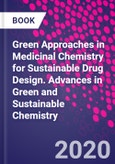Extensive experimentation and high failure rates are a well-recognised downside to the drug discovery process, with the resultant high levels of inefficiency and waste producing a negative environmental impact. Sustainable and Green Approaches in Medicinal Chemistry reveals how medicinal and green chemistry can work together to directly address this issue.
After providing essential context to the growth of green chemistry in relation to drug discovery in Part 1, the book goes on to identify a broad range of practical methods and synthesis techniques in Part 2. Part 3 reveals how medicinal chemistry techniques can be used to improve efficiency, mitigate failure and increase the environmental benignity of the entire drug discovery process, whilst Parts 4 and 5 discuss natural products and microwave-induced chemistry. Finally, the role of computers in drug discovery is explored in Part 6.
Please Note: This is an On Demand product, delivery may take up to 11 working days after payment has been received.
Table of Contents
Part 1: Green ChemistryGreen Chemistry Assisted Synthesis of Natural and Synthetic Compounds as Anticancer Agents
Antibacterial and Antimicrobial Coatings on Metal Substrate by Cold Spray Technique: Present and Future Perspectives
Graphene Oxide Nanosheets as Sustainable Carbocatalysts: Synthesis of Medicinally Important Heterocycles
Sustainable and Green Technologies for Synthesis of Potential Drugs Targeted Towards Tropical Diseases
Clay-Mediated Synthesis of Biologically Active Molecules: Green and Sustainable Approaches
The Role of Ionic Liquid in Medicinal Chemistry
Synthesis of Medicinally Important Heterocycles Inside the Nanoreactors Built in Non-conventional Reaction Media
Green Synthesis of Nanoparticles and Nanocomposites: Medicinal Aspects
Part 2: Methods and Synthesis
Use of Sustainable Organic Transformations in the Construction of Heterocyclic Scaffolds
One-Pot Synthesis of Medicinally Active Compounds
Organocatalytic Cycloaddition Reaction: A Gateway for Molecular Complexity
Diverse Synthesis of Steroids
Reactions in Water: Synthesis of Biologically Active Compounds
Solventless Reactions: Green and Sustainable Approaches in Medicinal Chemistry
Thiosugars in the Synthesis of Biologically Active Compounds
Part 3: Medicinal Chemistry
Implementing Green Chemistry for Synthesis of Cholesterol Lowering Statin Drugs
Sustainable Release of Nanodrugs: A New Biosafe Approach
Stimuli Responsive Sugar-Derived Hydrogels: A Modern Approach in Cancer Biology
Green Synthesis and Biological Evaluation of Anticancer Drugs
Green Chemistry and Synthetic Approaches in the Development of Antidepressant and Antipsychotic agents
Part 4: Natural Products Natural Spices in Medicinal Chemistry: Properties and Benefits
Medicinal Plants and Their Compounds With Anticancer Properties
Part 5: Microwave-Induced Chemistry
Microwave-Assisted Synthesis of Anti-tubercular Agents: A Novel Approach
Microwave-Induced Synthesis of Steroids and Their Chemical Manipulations
Microwave-Induced Synthesis as a Part of Green Chemistry Approach for Novel Anti-inflammatory agents
Part 6: Computers in Drug Discovery
Dipole Moment of Medicinally Active Compounds: A Sustainable Approach
Computational Methods and Tools for Sustainable and Green Approaches in Drug Discovery
Authors
Bimal Krishna Banik Vice President of Research and Education Development, Community Health Systems of South Texas, USA. Since being awarded his PhD by the Indian Association for the Cultivation of Science, Calcutta, Professor Banik has held positions as a Postdoctoral Fellow at Case Western Reserve University and Stevens Institute of Technology; Tenured Full Professor in Chemistry and First President's Endowed Professor in Science & Engineering at the University of Texas-Pan American, Edinburg; an Assistant Professor in Molecular Pathology at the University of Texas M. D. Anderson Cancer Center, Houston; and a Research Assistant Professor in Chemistry & Chemical Biology at Stevens Institute of Technology, New Jersey. Since 2014, he has been the Vice President of Research & Education Development of Community Health Systems of South Texas.Professor Banik has designed, synthesized, and identified novel beta lactams derived from polyaromatic compounds as anticancer agents. He is involved in the asymmetric synthesis, biological evaluation, delivery of compounds to increase the effectiveness and mechanism of actions studies of beta lactams and polyaromatic compounds as anticancer agents.
As the Principal Investigator, Professor Banik has been awarded $7.25 million in grants from the US National Institutes of Health, US National Cancer Institute, and Kleberg Foundation. He has also has more than 315 publications to his name (including peer-reviewed papers and patents, book chapters, books, perspectives, commentaries and reviews) along with approximately 460 presentation abstracts with 6000 citations. He is a reviewer of 93, editorial board member of 28, editor-in-chief of 9, founder of 4, associate editor of 4 and guest editor of 6 research journals. Furthermore, Professor Banik has presided over numerous research sessions at top conferences in the field, including one at the Nobel Prize celebration in Germany.








